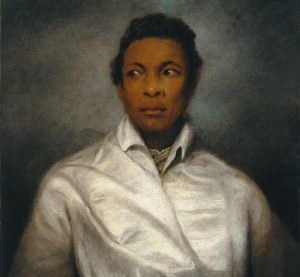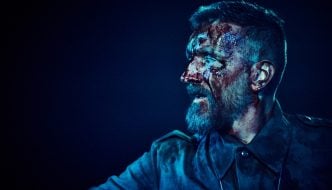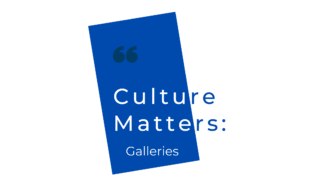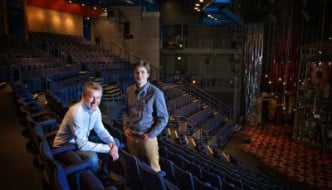
A Moor by James Northcote (1826). Courtesy of Manchester Art Gallery
The stage is set, the Royal Academy’s high budget production team seem to have the evenings live broadcast down to the proverbial T. James Northcote’s portrait of Ira Aldridge is appositely positioned between our evenings host Tim Marlow, and the artist of whom the painting has been cited as an ‘object of obsession‘ and source of inspiration; Sonia Boyce. Marlow opens the evening by discerningly alluding to the synchronicity between the pioneering achievements of Northcote’s painting and Boyce’s own artistic career. Both have significant ‘firsts’ to their names, and have broken boundaries within their respective fields – opening depths of possibilities for succeeding creatives.
In 1985 Sonia Boyce, at the age of 23, became the first black woman in the Tate’s collection, and only the fifth ever woman. Ira Aldridge is the first black Shakespearean actor, and the subject of Northcote’s portrait which was the first in Manchester Art Galleries collection. However, without wanting to undermine the significance of these pioneering feats, they do not bare a defining influence over either artist’s career. Aldridge’s performance as Othello, is purportedly the major height of the actor’s career, yet research shows that he delivered highly acclaimed performances by ‘whiting up’ to play the roles of King Lear and Macbeth. Therefore, the versatile thespian was definitely not type cast to Shakespeare’s leading black role.
Sonia Boyce has an incredibly fluid approach to categorisation, as identity politics is an incredibly complex, nuanced, and at times conflated field. Throughout Boyce’s career representations of identity have been addressed in a self-aware and performative, rather than formative way. It is a notion of ‘acting-out’, and defying confining preconceptions which creates a symbiosis, and sort of lineage between these phenomenal creatives illustrious careers.
Fluidity is central to Boyce’s mindset, it is clear that she cannot be bound by any predeterminations, groupings or potential stigmas – her politically charged outlook is wholly inclusive. This complete fluidity is something that is incredibly interesting, especially with recent movements towards non-binary identifications. In the build up to the evening’s talk I had been reading Griselda Murray-Brown’s 2012 article in the Financial Times, drawing comparisons between the life of Ira Aldridge and limitations faced by black actors in the current film and theatre industries. The article had suggested ‘colour blind’ casting as a possible solution to the restrictions created in a script by the caveat ‘black remains’ or ‘white remains’.
On first reading ‘colour blind’, my immediate intuition was that this potential solution was treading the path to becoming culturally insensitive very closely, and liable to criticism for ignoring histories of racial discrimination. However, Boyce’s inclusive approach to redressing imbalances plays with the idea of masking identities in performance, to such an extremity that colour becomes almost secondary to any act. Laurence Fishburne and Anthony Hopkins have both ‘blacked up’ to play the role of Othello, and some of Aldridge’s most acclaimed performances were in ‘white remains’ parts.
Therefore, it seems to me that a distinction must be drawn. Firstly, it must be made clear that progression in the industry resolves around designing more strong leading black roles – hopefully Marvel’s new blockbuster ‘Black Panther’ signifies a tangible shift in the big-budget and mainstream industry. Moving the industry forward, and dispelling the imbalance problem requires proactive writing rather than secondary casting solutions. However, when considering histories of inequality in great literature, an undeniable and considerable imbalance in opportunity cannot be ignored.
Therefore, it is with the blessing of Boyce’s ‘fluidity remains’ mindset, that ‘colour blind’ casting can be re-framed as a performative solution that attempts to break the shackles of conformity. A solution which releases equality in opportunity when performatively addressing histories of inequality in literature. This performative solution is conceivable ‘if, and only if’ it doesn’t attempt to paint over legacies of empire and discrimination. Narratives of colonisation cannot be ignored as they are completely intertwined with the way in which history is depicted.
Progression when addressing history is subjective, it is about perspective, Boyce nicely surmises this with a quote she repeats twice “the past does not sit still, because we are always thinking about it from the context of where we are”. Therefore, it is with Boyce’s incisive and measured reasoning when consider the life of Ira Aldridge, that it becomes conceivable to draw the conclusion that ‘colour blind’ casting (if tastefully and sensitively done) can break down and re-contextualise a history of discriminative barriers.
Marlow and Boyce, move conversation about this issue of imbalance towards Manchester’s Canal Street, and consider a history of association between drag (‘dressed resembling a girl’) and Shakespearean productions. When addressing this connection, one of the first points that needs to be made is that there is a gender-specific pronoun error in the English language. Masculinity and Femininity are – in themselves and of themselves – performative rather than formative. Issues of gender, race, sexuality and sensuality all criss-cross problematically, and representations move toward spectrums rather than binary forms.
Boyce considers a non-binary space to be concerned with the logical connective ‘one and the other’ rather than ‘one or the other’. Grasping this conjunctive form of grouping can be visualised through fluid and entangled Venn diagrams, rather than an atomistic and coercive vision of essentialism – Boyce is quick to point out that essentialism leads down a road to ‘racism’, ‘sexism’, and other forms of discrimination. The topic of identity is about how difference gets negotiated, a lot of Boyce’s work – in her own words – is about the question of entanglement, not about existential questions of ‘fitting in’ or ‘not fitting in’.
Boyce is incredibly eloquent in her fluidity, as at times it can be hard to convey issues which enter a post-structural zone so clearly. The artist’s dexterity and transferability in approach to the branches of the visual arts is phenomenal. This creates a burgeoning sense of excitement for the opening of her retrospective at Manchester Art Gallery in the coming month. For more information about this retrospective please visit MCR Art Gallery’s website.
Filed under: Art & Photography
Tagged with: fluidity, Ira Aldridge, James Northcote, MCR art gallery, Othello, Shakespeare, Sonia Boyce, Tim Marlow



Comments